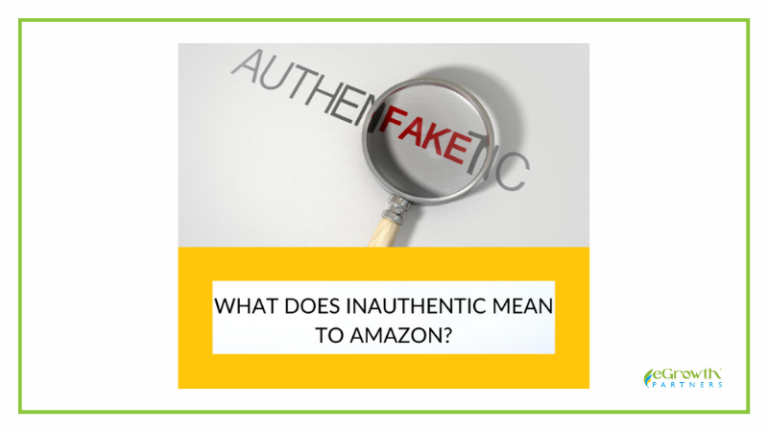I’ve been talking about inauthentic complaints in my book, blogs and speaking engagements since 2015 and yet this is still a very confusing issue for sellers. “Inauthentic” is still one of the top suspensions we work with week in and week out. It’s important because these suspensions can take a long time to resolve with Amazon and it is one of easiest suspensions to resolve if a seller has all their ducks in a row. So often, however, they don’t.
What does Amazon mean by inauthentic?
Sellers are often confused by this policy violation because they are confident that they are selling genuine goods. They think Amazon means counterfeit. This is a mistake. In most of our cases, our clients are selling genuine goods, but they are inauthentic because of WHERE the seller bought their goods. They are either selling gray market goods (unauthorized sources, diverted inventory), retail arbitrage, or liquidation goods.
Why does Amazon care so darn much?
Sellers are buying goods outside of the distribution channel set up by the brand which greatly increases the chances that the goods are stolen, counterfeit or have been resold many times before getting to the buyer which causes product quality issues like dirty, dusty, faded and damaged boxes and merchandise.
Amazon is committed to buyer satisfaction and avoiding liability, which means pristine goods bought from legitimate sources. They have also received a lot of pressure from the big brands to clean up the platform.
Why might Amazon suspect your inventory is inauthentic?
The algorithm is going through your buyer-seller messages, product reviews, product returns and seller reviews looking for problems. If a buyer complains about the product looking fake, faded, old, used or not matching the listing, that can lead to an inauthentic claim. Sometimes the complaint is not from a buyer but from the brand who suspects the inventory is coming from the gray market or is stolen. Brands have the right to control their distribution channel, so Amazon investigates their complaints.
What happens when your listing or amazon seller account is suspended for inauthentic?
The first thing Amazon asks for is 365 days’ worth of invoices or receipts. They want to see all the inventory you bought for that ASIN over the past year because a common trick by bad actors is to mix legit inventory in with gray market or black market (stolen) goods. They do this to lower the overall price of their goods and get to have a legit invoice if needed.
Next, Amazon verifies the invoices. That means they run them through software looking for signs of tampering/forgery. Then they reach out to the brand or distributor to verify the invoices. If they see any suspicious documents or can’t verify the invoices, they won’t reinstate the client. Verifying the invoices can take days or even weeks which makes this a difficult suspension to bounce back from.
In addition to the invoices, Amazon usually asks for a Plan of Action to accompany the invoices.
What can sellers do to resolve inauthentic complaints quickly?
The best thing sellers can do to recover from an inauthentic complaint is to be prepared, to have legit invoices and to address the problem that caused the complaint in the first place.
What does Amazon want to see in a plan of action for inauthentic?
The first thing sellers need to do is look inside their accounts. Review the past 60 days of refunds/returns, buyer-seller messages, seller reviews and product reviews. Look for signs of buyer dissatisfaction. These could be product quality issues, complaints of fake or counterfeit, missing parts, complaints of already being opened, or other complaints about how the product looks.
Once you know where the inauthentic complaint came from, you can write a plan of action to address it. In many of our POAs our clients commit to only buying from authorized sources. They commit to getting pre-authorized by the brand or distributor and, often, they commit to changing their sourcing practices. If product packaging is a problem, they may commit to better inspections and better dunnage and protection.
How can sellers avoid inauthentic complaints in the first place?
You can’t completely eliminate the possibility of an inauthentic complaint, but if your product is new, approved by the brand or authorized distributor and in excellent condition when it reaches the buyer, your chances are greatly reduced. If you have permission to sell that product on Amazon, then you’ll get reinstated faster. Good paperwork, planning, smart inspections and careful packing can go a long way. We find that with inauthentic, our client’s business practices are often flawed which makes them vulnerable.
If you understand what Amazon means by inauthentic, your appeals will be better. So many of our clients come to us after failing themselves first. Many of them fail because they are trying to argue that their products are new or not counterfeit rather than proving that they are buying from authorized sources. To all my clients who buy from the gray market or liquidators I want to say (again), it is your sourcing model that is making you vulnerable. We have clients who are constantly getting inauthentic complaints and others that never get them. Planning and being prepared makes a huge difference
HOW CAN WE HELP YOU?
We are known for helping suspended amazon seller accounts get reinstated, but our goal is to keep sellers from being suspended in the first place. We have more than 25 team members passionately working 7 days a week to win suspension appeals and protect Amazon sellers like you.
Contact us for specific advice on your situation:

Email: hello@egrowthpartners.com
Website: egrowthpartners.com
Facebook: egrowthpartners
Twitter: eGrowthPartners
Phone: 1-972-432-6398
JOIN US!
- Next speaking engagement – IRCE in June: Come meet Cynthia Stine in Chicago this summer: IRCE 2019 (June 25-28, McCormick Place, Chicago.)
- Future speaking engagement — ecom Chicago. Cynthia returns to Chicago in October (October 16-18, Elk Grove Village, IL).
NEWS NUGGETS
- We are aware that many sellers are incorrectly having their products reclassified as a Pesticide product on Amazon, usually requiring the seller to have to take a survey to reinstate the listing. We have been able to get the listings of foreign-based owners of so-called pesticide products reinstated and properly categorized as non-pesticides, so please Contact Us if you need help.
- A few days ago, many Amazon sellers received the following notice in their Seller Central Console: “Starting July 22, 2019, Amazon will suppress ASINs from Amazon Search whose titles do not comply with Amazon’s product title requirements. This is because our research shows that the ASIN titles that violate our policies result in poor customer experience. Please review Amazon’s FBA Product Title Requirements prior to July 15, 2019 to verify that your current titles meet our guidelines.” Sellers should be aware that this is happening and we are keeping our eyes open for any potential problems this may cause.
- Attn: apparel brands! This month Amazon is removing its generic size charts from all listings and making each brand create their own. This is designed to reduce size-related returns so take this seriously.
Our new Facebook Group Amazon Seller Advocates just passed 620 members! Join us for discussions of all things affecting Amazon sellers. Understand the context behind news announcements, changes to TOS and more! JOIN US!




